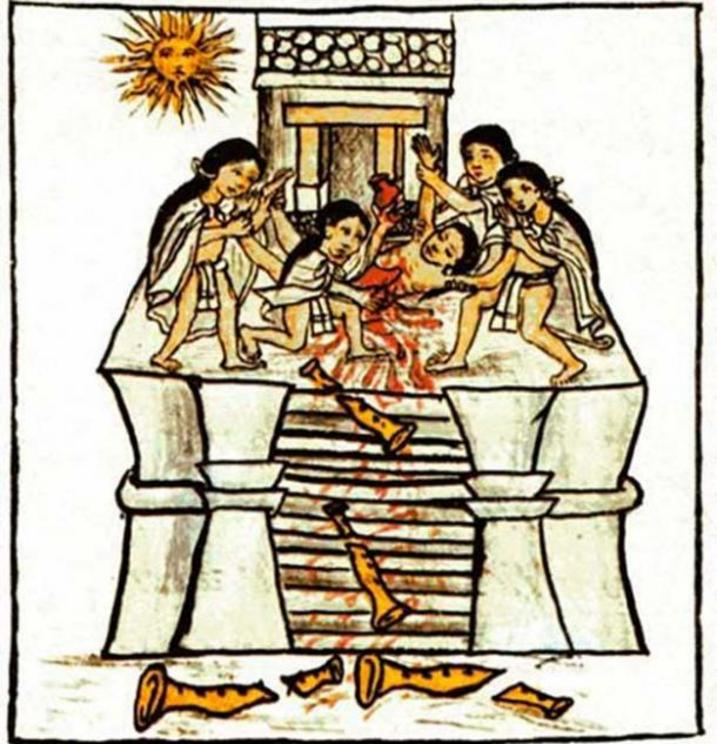First ever Aztec royal burial site could be indicated by jaguar, flamingo and child sacrifices
Archaeologists working in Mexico City have made a series of amazing finds and these could lead to the discovery of an Aztec Emperor’s long-lost tomb. A team of specialists made the find in one of the Aztec of Mexica’s holiest sites and it includes offerings to their gods and a young boy who was the victim of human sacrifice . Archaeologists are continuing to work at the site, and they have strong hopes that they will find the tomb of the most powerful of all Aztec Emperors, Ahuitzotl (1486-1502).
The team was working in the Zócalo Plaza, an area not far from the Mexican President’s Palace when they made the find. Some 500 years ago this area was also the center of Tenochtitlan, the Aztecs religious and political capital until it was captured by the Spanish Conquistadors in 1521. Archaeologists were working on the site of the main Aztec temple known today as the Templo Mayor which was once “a 15-story pyramid” according to the Jerusalem Post .
 Reconstruction of the Templo Mayor of Tenochtitlan where experts may have found an Aztec Royal Burial.
Reconstruction of the Templo Mayor of Tenochtitlan where experts may have found an Aztec Royal Burial.
A Box Full of Aztec Offerings
Experts had begun to excavate a circular sacrificial platform before the steps of the pyramid when they made their amazing discovery. They found a rectangular box made of stones and to their immense joy it contained a trove of Aztec sacrifices and offerings . They had been left there by priests over half a millennium ago who believed that this place was “the center of the universe” according to Reuters.
Archaeologists found a real treasure trove of items in successive layers in the box. Among the finds was a richly adorned jaguar, with “a carved wooden disk placed on the feline's back that was the emblem of the Aztec patron deity Huitzilopochtli, the war and sun god” reports the Nasdaq website. It seems that the jaguar was dressed in the manner of a Mexica warrior , which was interred in the box facing the west.
A Sacrificed Jaguar
On top of the sacrificed jaguar was a layer of offerings taken from the sea and these include starfish, seashells, and large amounts of coral, which was very much prized by the Mexica. These items demonstrate the extent of the Aztec’s territory because they were brought from the distant Pacific coast. It is likely that these offerings represented the watery underworld where the sun went at night. A sacrificed tropical bird, similar to a flamingo was also found in the box and this is thought to have symbolized the descent of Aztec warriors to the afterlife.
 A sacrificed jaguar was one of offerings found at the possible Aztec Royal Burial.
A sacrificed jaguar was one of offerings found at the possible Aztec Royal Burial.
Just off the pyramid’s steps, the archaeologists also found a smaller rectangular box, in which they made a grisly discovery. They found a little boy who had been sacrificed and he was dressed to “resemble the Aztec war god and solar deity” according to the Jerusalem Post . The Mexica practiced human sacrifice as they saw it as essential for the maintenance of the world order. It seems likely that the child was killed by having his beating heart cut out of his chest by a priest with an obsidian knife. Also found with the child was a series of knives made from flint and decorated with semi-precious stones.
 The body of a young man offered to Tezcatlipoca Huitzilopochtli found at the Aztec Royal Burial site.
The body of a young man offered to Tezcatlipoca Huitzilopochtli found at the Aztec Royal Burial site.
The team leader Leonardo Lopez Lujan is hopeful of making more discoveries as only a small portion of the box has been excavated because of the sheer amount of coral that was deposited in it. What is really exciting the experts is the possibility that the offerings and sacrifices could lead to the discovery of an Aztec royal burial. Remarkably while archaeologists have found Maya, Mixtec, and Zapotec royal tombs they have not found a single Aztec ruler’s grave.
The Tomb of the Emperor Ahuitzotl?
Contemporary reports state that the Tempo Mayor complex was the burial site of “three Aztec kings, all brothers who ruled from 1469 to 1502” reports the BBC. Chroniclers narrate that the ashes of these monarchs were buried near the great temple along with many offerings and the hearts of sacrificial victims. Despite the written records no-one has been able to find one of these royal burials. In recent years experts found a large statue of an Aztec goddess which they dated to 1502 the year that the Emperor Ahuitzotl died. The location of the rectangular box with the trove of offerings and sacrificial victims are near the monolith of the female deity .
 Archaeologists have fond numerous items in a site that is believed to be an Aztec Royal Burial.
Archaeologists have fond numerous items in a site that is believed to be an Aztec Royal Burial.
All of this means that there is the real possibility that the box contains the remains of this emperor, who greatly expanded the territories of the Aztecs and even threatened the Maya. The fact that a jaguar was found in the box may be a symbolic representation of the fearsome martial qualities of Ahuitzotl, who was one of the greatest military leaders in the history of Mesoamerica. If it is the case that archaeologists have found an Aztec Royal tomb it could greatly add to our knowledge of what was arguably the most important pre-Columbian civilization .

